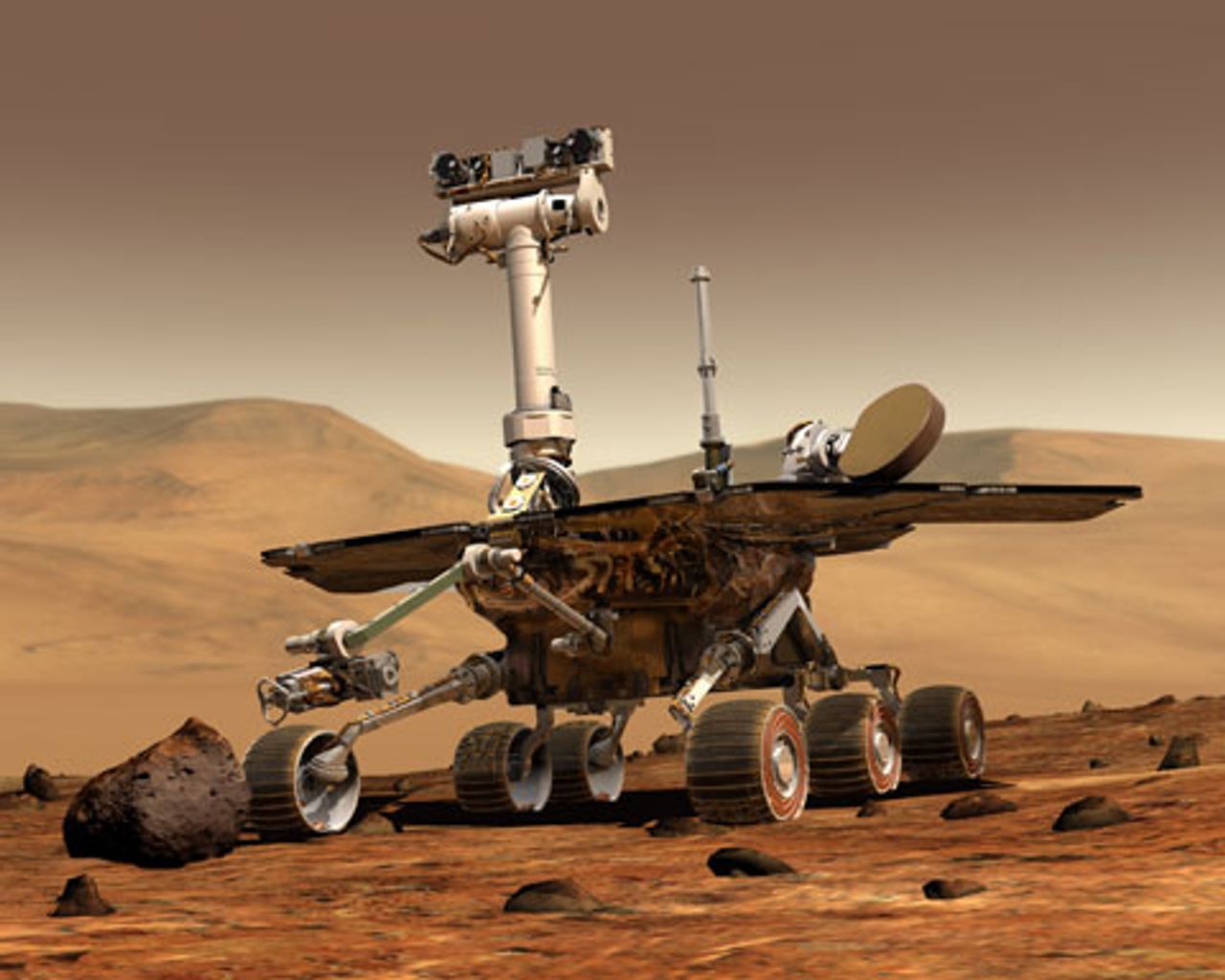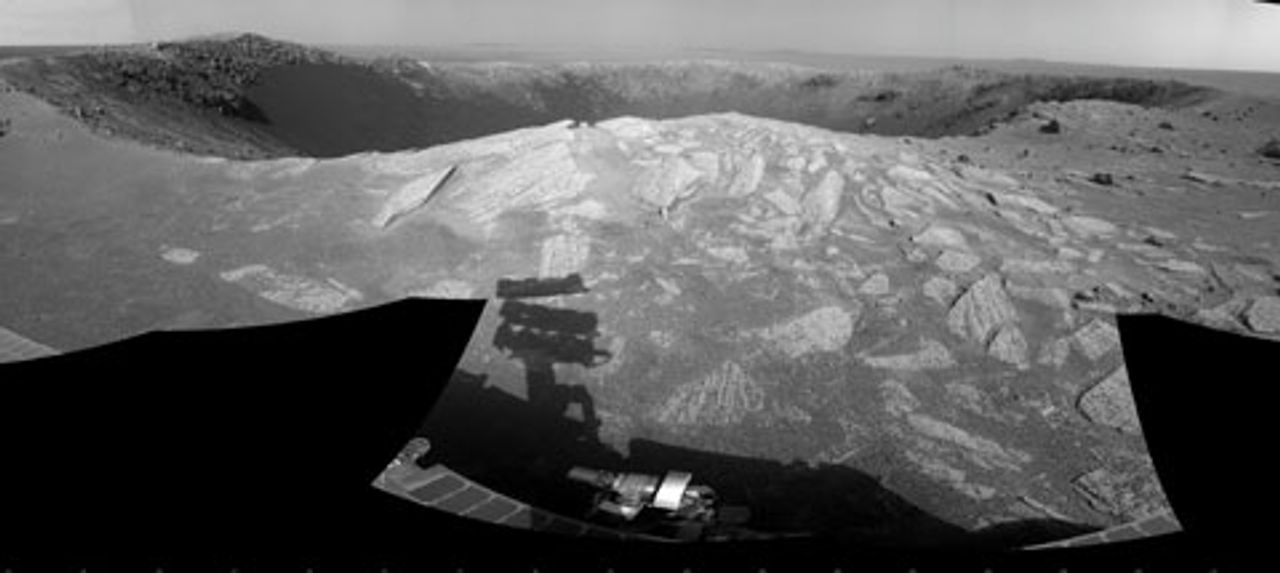 Artist concept of rover on Mars [Courtesy NASA]
Artist concept of rover on Mars [Courtesy NASA]This month marks seven years since two NASA rovers landed on Mars and began a new era in scientific exploration of the fourth planet from the sun. The rover Spirit landed on Mars on January 4, 2004, while its identical twin, Opportunity, landed January 24, on the opposite side of the planet. Between them, they have taken 250,000 photographs of the planet’s surface, marking a quantum leap in man’s understanding of the geology of Mars.
The two robots, each about the size of a golf cart, were built for a mission originally expected to last for three months. They were built to travel 1 kilometer each, but Spirit explored 8 kilometers before its current hibernation, while Opportunity has covered nearly 27 kilometers.
The technology used has proven highly adaptable, and engineers at the Jet Propulsion Laboratory (JPL) have been able to extend the life of the mission more than 20-fold. Their improvisations have been remarkably effective: turning the rovers around and running them exclusively in reverse gear for the last several years to reduce wear and tear; or carrying out instrument readings by the on-board spectrometer over a period of several days in order to conserve the small amount of radioactive cobalt-57 used by the sensor, which has a half-life of less than a year.
Spirit became trapped in sand in 2009 and was unable to move to a sunward-facing slope during the ensuing Martian winter, drastically reducing the energy generated by its solar panels. The rover went into low-power hibernation, with its last transmission to NASA on March 22, 2010, but NASA scientists still hope it will revive during the current Martian summer, which reaches its peak in March.
 The Santa Maria crater on Mars [Courtesy NASA]
The Santa Maria crater on Mars [Courtesy NASA]Opportunity continues its explorations virtually unimpeded by the severe conditions that prevail on the surface of Mars. By the middle of this month, it had reached the southeastern edge of a crater named Santa Maria, which has a diameter of about 100 meters.
The rover will be out of touch with its controllers for 16 days, starting January 27 because of the solar conjunction, a period when the Earth and Mars are on opposite sides of their orbits with the sun in between them, which disrupts radio communication. It is the fourth such period of temporary blackout since the two rovers landed on Mars.
NASA will also stop sending commands to the Mars Reconnaissance orbiter and the Mars Odyssey orbiter, the two spacecraft it operates in Mars orbits, because of the possibility that radiation from the sun could corrupt the signal and produce incorrect results. The two orbiters will continue to download data to Earth, albeit at a reduced rate because of the interference.
Data from Opportunity is uploaded daily to the Odyssey orbiter for eventual relay to Earth. The rover has already received a set of commands to drive its scientific activities during the 16-day moratorium on direct transmissions.
After two months studying the smaller crater, Santa Maria, it will begin the longer trek to the much larger crater Endurance, 22 kilometers in diameter, whose rim appears on the horizon of the photograph of Santa Maria released by NASA this week. Opportunity will be targeted at a part of the big crater’s rim that appears from orbit to be adjacent to water-bearing minerals.
The search for water was the main focus of the rover mission, and the two robots uncovered evidence of a previously unknown water cycle in the relatively recent history of the planet. It has been known since the 1970s that liquid water once flowed on the surface of the planet. Spirit and Opportunity found evidence that this was a widespread phenomenon, detecting minerals near both their widely separated landing sites that require the presence of water for their formation.
When Spirit suffered a malfunction in 2006, when its right front wheel stopped working, JPL began to operate it in reverse, forcing the locked wheel to drag along the surface and dig a groove through the Martian soil. This shallow trench exposed deposits of pure silica under the soil, a substance formed by a reaction between rock and thermally heated water. This suggested the simultaneous presence of heat and liquid water, two of the critical components for the formation of life.
The knowledge gained from seven years of operation of the rovers provides a powerful basis for the next scientific mission to the surface of Mars, the Mars Science Laboratory (MSL). This is scheduled for launch in December 2011, with arrival on Mars in August 2012. The MSL will unload a rover called Curiosity, a mobile laboratory with much greater speed and scientific capability, including an on-board laser to vaporize rocks and soil and study their component parts. The MSL will be focused on the search for evidence of living organisms, particularly those based on carbon like life on Earth.
John Callas, the project manager for the Mars Exploration Rover, discussed the impact of the two rovers on scientific understanding of the planet, in an interview with Space.com. He concluded, “for me, these rovers have rewritten the history books for Mars. One of the great intangibles is that, in addition to all the scientific discoveries, these rovers have made Mars a familiar place. Mars is now our neighborhood.”
